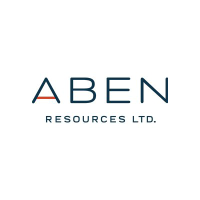
Aben Minerals Ltd (PK) (ABNAF)
USOTC

Suite 1610 – 777 Dunsmuir Street, Vancouver, BC, V7Y 1K4, CANADA www.abenresources.com. TSX-V Trading Symbol: ABN Email:...
| 期間 † | 前日比 | 前日比 % | 始値 | 高値 | 安値 | 平均出来高 | VWAP | |
|---|---|---|---|---|---|---|---|---|
| 1 | 0.0115 | 29.4871794872 | 0.039 | 0.0508 | 0.039 | 4002 | 0.04493527 | CS |
| 4 | -0.0035 | -6.48148148148 | 0.054 | 0.054 | 0.039 | 2891 | 0.04741378 | CS |
| 12 | -0.00503 | -9.05816675671 | 0.05553 | 0.0576 | 0.039 | 4638 | 0.05131862 | CS |
| 26 | -0.0074 | -12.780656304 | 0.0579 | 0.0699 | 0.039 | 4058 | 0.05466362 | CS |
| 52 | -0.0245 | -32.6666666667 | 0.075 | 0.0902 | 0.039 | 5481 | 0.06241179 | CS |
| 156 | -0.3295 | -86.7105263158 | 0.38 | 0.488 | 0.039 | 44225 | 0.2591386 | CS |
| 260 | -0.5295 | -91.2931034483 | 0.58 | 1.2162 | 0.039 | 72680 | 0.54036338 | CS |
 andrew16
4年前
andrew16
4年前
 andrew16
4年前
andrew16
4年前
 Vector93
5年前
Vector93
5年前
 ThSeeker
5年前
ThSeeker
5年前
 ThSeeker
5年前
ThSeeker
5年前
 Vector93
5年前
Vector93
5年前
 ThSeeker
5年前
ThSeeker
5年前
 ThSeeker
5年前
ThSeeker
5年前
 ThSeeker
5年前
ThSeeker
5年前
 Vector93
5年前
Vector93
5年前
 ThSeeker
5年前
ThSeeker
5年前
 Vector93
5年前
Vector93
5年前
 ThSeeker
5年前
ThSeeker
5年前
 Vector93
5年前
Vector93
5年前
 ThSeeker
5年前
ThSeeker
5年前
 ThSeeker
5年前
ThSeeker
5年前
 ThSeeker
5年前
ThSeeker
5年前
 ThSeeker
5年前
ThSeeker
5年前
 ThSeeker
5年前
ThSeeker
5年前
 ThSeeker
5年前
ThSeeker
5年前
 ThSeeker
5年前
ThSeeker
5年前
 Proven and Probable
5年前
Proven and Probable
5年前
 copleybmt
6年前
copleybmt
6年前
 Proven and Probable
6年前
Proven and Probable
6年前
 copleybmt
6年前
copleybmt
6年前
 MC2 Atlantis
6年前
MC2 Atlantis
6年前
 copleybmt
6年前
copleybmt
6年前
 Proven and Probable
6年前
Proven and Probable
6年前
 Proven and Probable
6年前
Proven and Probable
6年前
 7Card
6年前
7Card
6年前
 Lidoshuffle
6年前
Lidoshuffle
6年前
 7Card
6年前
7Card
6年前
 Proven and Probable
6年前
Proven and Probable
6年前
 7Card
6年前
7Card
6年前
 shurtha2000
6年前
shurtha2000
6年前
 7Card
6年前
7Card
6年前
 Proven and Probable
6年前
Proven and Probable
6年前
 shurtha2000
6年前
shurtha2000
6年前
 SPARK'S FLY
6年前
SPARK'S FLY
6年前
 invest0r
6年前
invest0r
6年前
 SPARK'S FLY
6年前
SPARK'S FLY
6年前
 Richdollas
6年前
Richdollas
6年前
 invest0r
6年前
invest0r
6年前
 copleybmt
7年前
copleybmt
7年前
 ValueFact
7年前
ValueFact
7年前
顧客サポート: +44 (0) 203 8794 460 | support@advfn.com
ADVFNのサービスをご利用いただくには、利用規約